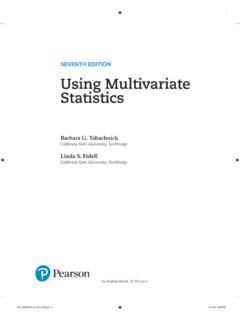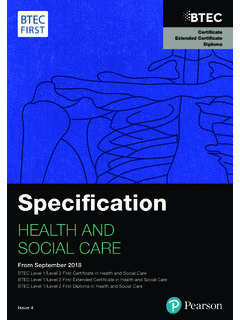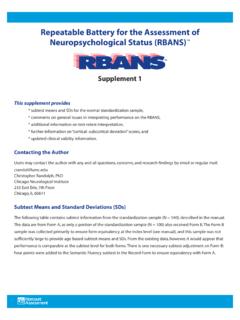Transcription of Physics 100A Homework 4 – Chapter 5 Newton’s First Law A) …
1 Physics 100A Homework 4 Chapter 5 Newton s First Law A)If a car is moving to the left with constant velocity then the net force applied to the car is zero. B) An object cannot remain at rest unless the net force acting on it is zero. C) An object has constant acceleration if the net force acting on it is constant. Understanding Newton s Laws A)An object cannot remain at rest unless the net force acting on it is zero. B)If a block is moving to the left with constant velocity the net force applied to the block is zero. C) A block of mass 2 kg is acted upon by two forces: 3N (directed to the left) and 4N (directed to the right). What can you say about the block's motion? The net force is point to the right, so the object could - be moving to the right and accelerating to the right (speeding up) - be moving to the left and accelerating to the right (slowing down) - be at rest and on the verge of moving to the right D) A block pulled with a constant force will have a constant acceleration in the same direction as the force.
2 E) Two forces, of magnitude 4N and10N, are applied to an object. The relative direction of the forces is unknown. The two limits for adding the forces give that the magnitude of the net force must be NFNnet146 So 5N is excluded Free-Body Diagrams Chadwick is pushing a piano across a level floor (see the figure). (Intro 1 figure) The piano can slide across the floor without friction. If Chadwick applies a horizontal force to the piano, what is the piano's acceleration? A), B) and C)The three forces acting on the piano are: Chadwick pushing to the right; gravity down; normal force from the floor up. Copyright 2010 Pearson Education, Inc. All rights reserved. This material is protected under all copyright laws as they currently exist. No portion of this material may be reproduced, in any form or by any means, without permission in writing from the publisher.
3 5 1 Chapter 5: Newton s Laws of Motion James S. Walker, Physics , 4th Edition D), E) and F) When going up the inclined plane, the three forces acting on the piano are: Chadwick pushing parallel to the plane; gravity down; normal force up and perpendicular to the incline. Motion of a Block with Three Forces Three forces of magnitudes F1= N , F2= N, and F3= N are applied to a block of mass m= kg, initially at rest, at angles shown on the diagram. In this problem, you will determine the resultant (net) force by combining the three individual force vectors. All angles should be measured counterclockwise. A)Find the magnitude of the resultant 321 FFFF rrrrr++= Add the x and y components independently )180cos()325cos()25cos(321321 FFFFFFF xxxrx++=++= )180cos( )325cos( )25cos( ++= )180sin()325sin()25sin(321321 FFFFFFF yyyry++=++= )180sin( )325sin( )25sin( =++= Copyright 2010 Pearson Education, Inc.
4 All rights reserved. This material is protected under all copyright laws as they currently exist. No portion of this material may be reproduced, in any form or by any means, without permission in writing from the publisher. 5 2 yA) and B) Find magnitude and direction ) () (2222=+=+= N x o73) (tan1== From the x-axis 360 -73 =287 N Chapter 5: Newton s Laws of Motion James S. Walker, Physics , 4th Edition C) and D) Magnitude and direction of the acceleration It points in the same direction as the force. E) How far (in meters) will the block move in Recall that it starts from rest. )5)( (2100212200=++=++=attvddm The Normal Force A) A man is pulling up on the suitcase, while it rests on the floor. Fpull N FpullWNWF pullN == +0 W The magnitude of the normal force is equal to the magnitude of the weight of the suitcase minus the magnitude of the force of the pull.
5 B) The man sits on the suitcase. Copyright 2010 Pearson Education, Inc. All rights reserved. This material is protected under all copyright laws as they currently exist. No portion of this material may be reproduced, in any form or by any means, without permission in writing from the publisher. 5 3 Man: Nm/s-Wm=0 Nm/s=Wm Suitcase: N-Nm/s-W=0 N=Nm/s+W = N=W+Wm You are pulling your little sister on her sled across an icy (frictionless) surface. When you exert a constant horizontal force of 120 N, the sled has an acceleration of m/s2. WmMan free body diagramNm/sNm/sWNIf the sled has a mass of kg, what is the mass of your little sister? 4. Picture the Problem: You exert a horizontal force that accelerates both your little sister and the sled.
6 Strategy: Apply Newton s Second Law to the sled + sister combination, and solve for the mass of your sister. Solution: 1. Use Newton s Second Law to find the total mass of the sled + sister combination: total2120 N48 m/sFma=== 2. Find the mass of your sister by subtracting: sistertotalsled 48 kg kg41 kgmmm== = Insight: A more massive sister would decrease the acceleration of the sled if the pulling force remained the same. Chapter 5: Newton s Laws of Motion James S. Walker, Physics , 4th Edition Newton s Third Law Discussed A) Every force has one and only one 3rd law pair force. T B) The two forces in each pair act in opposite directions. T C) The two forces in each pair do not act on the same object. F D)The two forces in each pair have the same origin. F E) The two forces of the pair always act on different objects.
7 F F) The accelerations of the two objects have the same magnitude and direction. F G) The force on the moon due to the earth is equal in magnitude to, and in the opposite direction from, the force on the earth due to the moon. Blocks in an Elevator Ranking Three blocks are stacked on top of each other inside an elevator as shown in the figure. Copyright 2010 Pearson Education, Inc. All rights reserved. This material is protected under all copyright laws as they currently exist. No portion of this material may be reproduced, in any form or by any means, without permission in writing from the publisher. 5 4 F2/3 W2W3F3/2 F1/2 F2/1 NW1A) Elevator at rest Whole system: 0321= WWWN ) )(321(321=++=++=WWWNN Block 1: 02/11= FWN02/11321= ++FWWWW *)32(322/1=+=+=WWFN Block 2: 02/321/2= FWF02/3232= +FWWW *)3(32/3===WFN The action and reaction pairs are equal in magnitude.
8 The ranking is then Ffloor on 1 > F1/2 > F2/3 There is no contact force between block 3 and 1 so F1/3 =0 B)Elevator moving upward with increasing speed (accelerating upward) There will be a term proportional to the acceleration on the RHS of the equations. This will make all the values higher but the order will remain. Chapter 5: Newton s Laws of Motion James S. Walker, Physics , 4th Edition On vacation, your 1400-kg car pulls a 560-kg trailer away from a stoplight with an acceleration of m/s2. 18. Picture the Problem: The free body diagrams for the car and the trailer is shown at right. The diagram assumes there is no friction. Strategy: In order to determine the forces acting on an object, you must consider only the forces acting on that object and the motion of that object alone.
9 For the trailer there is only one force 1 Frexerted on it by the car, and it has the same acceleration ( m/s2) as the car. For the car there are two forces acting on it, the engine and the trailer 2Fr1 Fr. Apply Newton s Second and Third Laws as appropriate to find the requested forces. Solution: 1. (a) Write Newton s Second Law for the trailer: ()()()21 560 kg kNm== == FFaxxrrr 2. (b) Newton s Third Law states that the force the trailer exerts on the car is equal and opposite to the force the car exerts on the trailer: ()1 kN = Fxr 3. (c) Write Newton s Second Law for the car: ()()()2 1400 kg kNM=== FaxCopyright 2010 Pearson Education, Inc. All rights reserved. This material is protected under all copyright laws as they currently exist. No portion of this material may be reproduced, in any form or by any means, without permission in writing from the publisher.
10 5 5 xrr Insight: The engine force must be because it must both balance the force from the trailer but also accelerate the car in the forward direction, requiring an additional kN of force. 2Fr( kNx) Insight: Another way to view the answer to (b) is to say the inertia of the heavier box shields the lighter box from experiencing some of the pushing force. In case (a) the lighter box provides less shielding and the contact force is greater. Two crewmen pull a raft through a lock, as shown in the figure. One crewman pulls with a force of 130 N at an angle of 34 relative to the forward direction of the raft. The second crewman, on the opposite side of the lock, pulls at an angle of 45 . With what force should the second crewman pull so that the net force of the two crewmen is in the forward direction?














